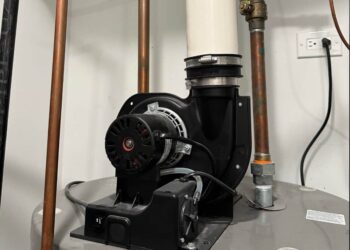Your home’s primary entrance is more than just a functional space—it sets the tone for the entire house, making a statement about your style and giving visitors their first impression of your home. Beyond aesthetics, your entrance plays a critical role in ensuring security, energy efficiency, and ease of access. With so many factors to consider, it’s important to balance beauty, functionality, and safety when designing or upgrading your home’s entryway.
One of the most important elements of any entrance is the front doors. These are not only a major part of the house’s aesthetic but also serve as the main line of defense against intruders and the elements. When planning or refining your entrance, there are several key considerations to keep in mind to ensure that your home’s primary access point is both welcoming and secure.
1. Focus on Security First
Security should be at the top of the list when considering your home’s primary entrance. A strong and secure entrance deters potential intruders, ensuring peace of mind for you and your family.
Choose a Sturdy, Secure Door
The material and construction of your front door have a huge impact on security. Solid wood, steel, or fiberglass doors are ideal choices for durability and protection. Steel doors, in particular, offer the highest level of security because they are resistant to forced entry and weather-related wear. If you prefer a wooden front door for its aesthetic appeal, choose one made from solid hardwood rather than hollow-core varieties, which are much easier to break through.
Also, consider doors with internal reinforcement or those that are impact-resistant, especially if you live in an area prone to storms or high winds.
Invest in High-Quality Locks and Hardware
Even the strongest door can be compromised without a good locking system. A deadbolt is a must for front doors, as it provides an extra layer of protection beyond a standard door handle lock. Opt for a deadbolt that extends at least one inch into the doorframe for maximum security. Additionally, a door viewer or smart doorbell camera allows you to see who’s outside without opening the door, adding another layer of protection.
Smart locks have become increasingly popular, offering keyless entry through fingerprint scanning, passcodes, or mobile apps. These modern locking systems offer convenience and enhanced security, particularly if you often have visitors, deliveries, or service people coming to your home.
2. Maximize Curb Appeal
Your entrance is one of the first things visitors see, so it’s important that it reflects the overall style of your home. A well-designed entrance not only adds aesthetic appeal but also increases the value of your property.
Style and Design of the Door
Your front door should complement the architectural style of your home. For a traditional or classic look, choose doors with detailed moldings, panels, and perhaps even sidelights or a transom window above the door. Modern homes often benefit from sleek, minimalist doors with clean lines, often made from steel or fiberglass with large glass panels for a contemporary feel.
Color is another important consideration. While neutral tones like black, white, or wood finishes are classic choices, don’t be afraid to go bold with a statement color that adds personality. A brightly colored door can create a welcoming focal point that contrasts beautifully with more subdued exteriors.
Incorporate Decorative and Functional Lighting
Outdoor lighting is essential for both security and ambiance. Well-placed lights ensure that your entrance is safe to navigate at night and create a welcoming atmosphere. Consider installing wall sconces on either side of the door or an overhead pendant light for a classic, balanced look. For added security, motion-activated lights or smart lighting systems can deter intruders while providing convenience.
Additionally, path lighting leading up to the entrance can add a touch of elegance and make your home’s exterior more inviting.
3. Consider Energy Efficiency
Your home’s primary entrance can have a significant impact on your overall energy efficiency. Heat loss or gain through doors and windows can drive up energy bills, so it’s important to choose materials and designs that enhance insulation and reduce energy waste.
Insulated Doors
Energy-efficient front doors are designed with insulation in mind, often featuring a foam core or thermal break. Fiberglass and steel doors are especially good at providing insulation compared to traditional wood doors. Look for doors that are Energy Star certified, as these meet strict efficiency guidelines and can help keep your home more comfortable year-round.
Proper Sealing and Weatherstripping
Gaps around doors can allow air to escape or enter your home, impacting temperature control. Weatherstripping and door sweeps help seal any gaps between the door and the frame, preventing drafts. Regularly check your front door for any signs of wear or damage to the seals, and replace them as needed to maintain efficiency.
4. Think About Accessibility and Ease of Use
Accessibility is another important consideration when designing your home’s entrance. Whether you have family members with mobility issues, or you’re thinking about future needs, a well-designed entrance should be easy to navigate for everyone.
Choose a Door with Accessible Features
Consider installing wider doors to accommodate wheelchairs or walkers. Standard doors are typically 32-36 inches wide, but upgrading to a 36-inch-wide door can make a big difference for those who need extra space. Lever-style door handles are another accessible option, as they are easier to operate than traditional doorknobs, especially for individuals with limited hand strength or dexterity.
Create a Step-Free Entryway
A step-free entrance is a great feature for any home, making it easier for those with mobility issues or even for bringing in heavy items like groceries. If your entrance currently has steps, consider adding a ramp or gently sloping pathway to ensure easy access for all.
5. Pay Attention to Maintenance and Durability
Your home’s entrance takes a lot of wear and tear, especially if you live in an area with harsh weather conditions. Choosing materials that are low-maintenance and durable will save you time and money in the long run, while also keeping your home looking its best.
Weather-Resistant Materials
Fiberglass and steel doors are both excellent options for durability, as they are resistant to warping, cracking, and splitting, unlike wood. Fiberglass, in particular, is a great choice for coastal homes or areas with extreme weather, as it withstands moisture and salt without deteriorating.
For wood doors, regular maintenance such as sealing or painting is required to protect them from the elements. Look for doors with UV protection to prevent fading if your front door is exposed to direct sunlight.
Regular Cleaning and Upkeep
To keep your entrance looking fresh, clean it regularly. Wipe down doors, sweep away debris from the threshold, and clean any glass panels to maintain visibility and aesthetics. Check for signs of wear on the locks, handles, and hinges, and lubricate moving parts as needed.
Creating a Welcoming and Secure Entrance
Your home’s primary entrance serves many purposes—it’s the gateway to your sanctuary, a reflection of your personal style, and a key element in your home’s security and energy efficiency. By carefully considering elements such as the design, security, accessibility, and maintenance of your front doors and entryway, you can create a space that is both inviting and protective. Whether you’re upgrading for aesthetics or focusing on enhancing safety, investing in your home’s entrance is a decision that pays off in both form and function.





